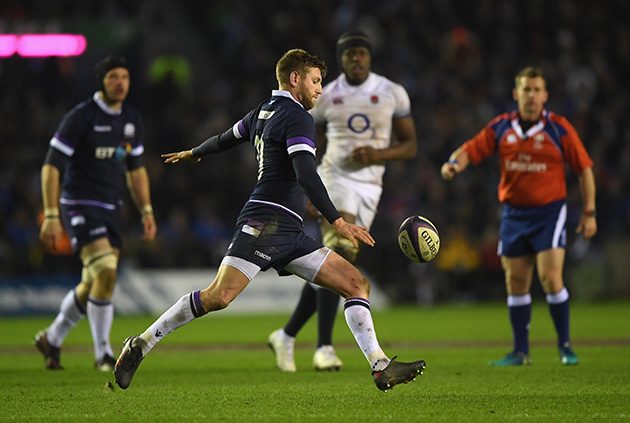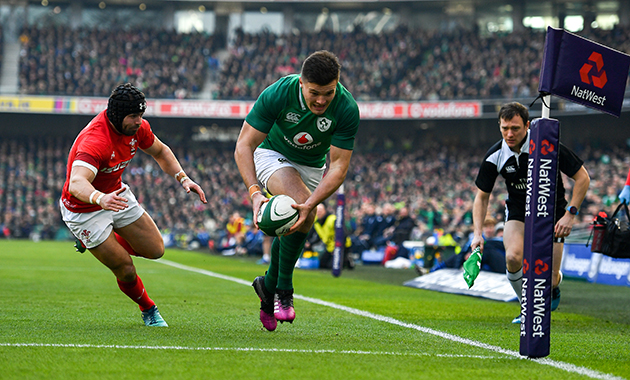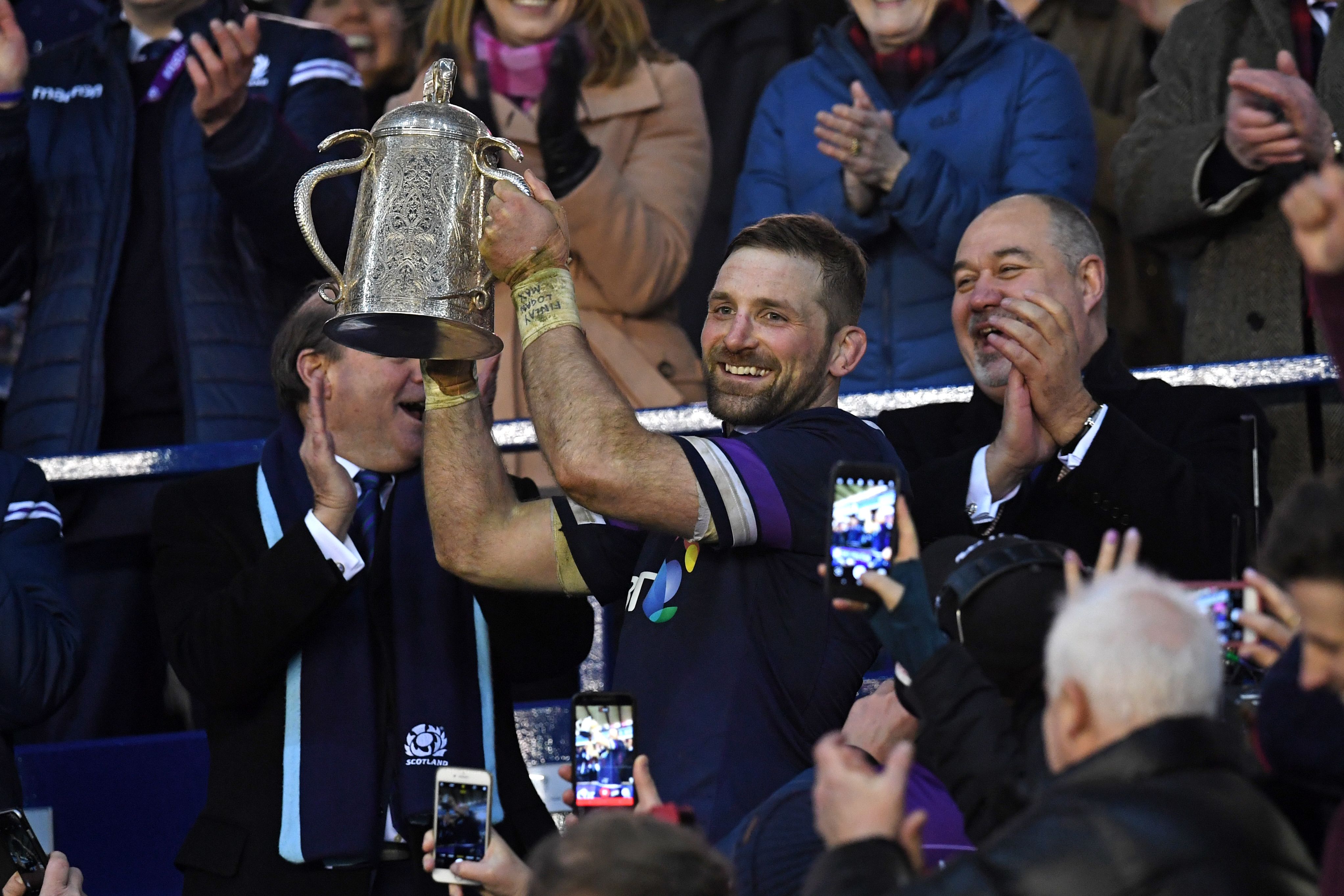From Finn Russell’s brilliance to Mathieu Bastareaud’s power, Paul Williams picks out his highlights from round three of the 2018 Six Nations
Six Nations 2018 Round Three – Six things we learnt
Scotland play YouTube rugby
To find 80 minutes of highlight reel rugby you usually need to scour the web for a few hours, carefully avoiding search words like hooker and big tackle. As of round three of the Six Nations, you can just re-watch Scotland v England 2018. It was a remarkable performance.
Finn Russell arguably had the game of the tournament so far, from any player in any team. His line kicking was exceptional, always finding the grass not the player, and forced England’s back three to deal with stacks of messy rolling balls instead of clean takes in the air.
Yet while his feet were outstanding, it was his hands that deserve the thumbs-up Facebook likes. His pass in the 31st minute was one of the best that the tournament has ever seen.
With so many defensive systems utilising a ‘rabbit’ who shoots out of the middle of the defensive line, it was awesome to see Russell totally negate it. Floating a miss-two pass over the top of the English defensive line he left Jonathan Joseph stranded in the middle of the field looking up at the sky like he’d just seen a cloud shaped like the Calcutta Cup.
Related: Finn Russell exclusive interview
Russell’s brilliance was matched by Huw Jones, who delivered a centre’s performance that has not been seen since Brian O’Driscoll shredded the line in his early days.

Central figure: Huw Jones powers over for his second try (Getty Images)
Jones’s try in the 38th minute was ballsy. Most players, when faced with a covering full-back on one side and a wing on the other, would have stepped to their left or right and taken on one of the defenders – allowing them to fend with their inside arm.
Jones ignored this option and decided to school both Mike Brown and Anthony Watson by running straight through the middle.
All of the above, of course, wouldn’t have been possible without the groundwork of Hamish Watson, who was sucking ball off the deck like an industrial vacuum.
Ireland play far more than ten-man rugby
The build-up to Ireland v Wales largely centred on previous comments from Warren Gatland concerning Joe Schmidt’s style of play. The implication being that it was narrow, ten-man rugby. Nothing could have been further from the truth against Wales. This was 15-man, all-court rugby.
It is very easy to get sucked into the notion that Ireland play ten-man rugby because they do it so well. Against Wales, their set-piece was rock-solid, the maul and contact work was precise, and they arguably have the most consistent pair of half-backs in world rugby.

In the clear: Jacob Stockdale scores his second try against Wales (Getty Images)
But to call it ten-man rugby does an injustice to the back-line, who collectively made eight clean breaks and beat 12 defenders (compared to Wales who beat just five defenders and made four clean breaks). Even Rob Kearney, who usually spends more time in the air than Donald Trump’s wig, made three clean breaks and beat three defenders.
And just when you thought that every player had made a contribution, Conor Murray went one step further and banged over a penalty in the 76th minute.
Irish rugby is very hard to categorise due to its flexibility and ability to morph during the game, but ten-man rugby it most certainly isn’t.
Wales should find positive in defeat
Wales hadn’t gone this long without getting their hands on some egg since Edwina Currie dropped the salmonella bomb in the 1980s. With just 31% of the ball and 25% of the territory, this was rugby starvation at its most severe.

Winging in: Steff Evans scores Wales’ third try against Ireland (Getty Images)
And whilst they recorded another defeat, which ended their title chances, there was a genuine positive to come from the game – Wales scored three tries. Scoring three tries in defeat may seem a rather pointless statistic, but for Wales it isn’t.
Over the past five seasons Wales have struggled to score tries even when they’ve had stacks of territory and possession. In recent years they’ve had 65% of the ball/territory and still failed to pass the ball adequately along the back-line.
That wasn’t the case in Ireland. Despite being thoroughly outplayed on the deck, Wales scored three well-executed tries and, more importantly, with forwards handling the ball at speed – Josh Navidi being a prime example.
Wales won’t be handling any silverware this season, but they are finally selecting players who can handle the ball, even when it is in short supply – something which has been severely lacking in recent seasons.
France 34-17 Italy Talking Points from Marseille
The key talking points from France’s 34-17 win…
Ireland v Wales Talking Points from the Aviva Stadium
Ireland 37-27 Wales Talking Points Ireland v Wales…
Scotland v England Talking Points from BT Murrayfield
Scotland v England Talking Points from BT Murrayfield…
Can England now be questioned?
England’s record under Eddie Jones is remarkable and they are undoubtedly contenders for the World Cup next year. Plus, the loss to Scotland may not be such a bad thing for England.
It is very difficult to ask questions of success because winning implies that there can’t be anything wrong. But, of course, this is rarely the case. The question of who should play hooker or full-back for England has been seemingly off limits for a long time – you need only look at Eddie Jones’s recent response to any negative feedback regarding team selection.
For England to progress, those questions need to be asked. Does having three second-rows on the field (Maro Itoje, Joe Launchbury and Courtney Lawes) make sense when the reasonably diminutive, shorter levered Hamish Watson and John Barclay are running riot?

Question time: Should there be changes to the England line-up? (Getty Images)
English rugby is in an enviable position leading in to the World Cup, but that doesn’t mean questions can’t be asked and answers found. After all, if your players are under the scrutiny of seven CCTV cameras, then three or four questions about full-backs, hookers, flankers and locks shouldn’t be too much to ask.
Mathieu Bastareaud is a one-man pod
We’re used to seeing pod systems in rugby, where three players line up next to each other, one to carry the ball and the other two to defend the ruck when contact is made. What we’re not used to is seeing one player do that job on his own.
Mathieu Bastareaud’s performance for France against Italy, as with most of his performances, redefines what we think of as a centre. There was no pace to worry about, no sidestep to defend, no dummy to be confused by, just a 20st offloading monster who is almost impossible to put on the ground in less than three seconds.

Power surge: Mathieu Bastareaud is a hard ball-carrier to stop (Getty Images)
Bastareaud beat seven defenders against Italy, more than anyone else on either team, and allowed France to set up ruck after ruck after ruck in midfield – without having to over commit players.
And even when he was stopped he still managed to creep forward slowly and steadily, which, with France wearing their white strip made it look like a piece of the Antarctica’s Lambert Glacier had sheared off and was now making its way through Marseille.
As good as he was, one question does remain. How good would he be if he was a more manageable 18st?
A knock-on in the tackle shouldn’t be a knock-on
Rugby doesn’t exactly need any more law changes. It’s hard enough to keep up with the regulations as it is. However, one law that does require a little tinker is when the ball is knocked forward by the tackler in a tackle.

Tough law: England had a try chalked off after Courtney Lawes knocked on in a tackle (Getty Images)
Courtney Lawes’s tackle on John Barclay was a classic example of why the situation needs addressing. The physics of a head-on tackle mean that all of the defender’s force is moving forward, therefore any contact made by the hand will cause a knock-on.
The situation is made even more unfair with the necessity to wrap your arms around the ball-carrier, as not using your arms makes it far less likely that you will hit the ball forward and concede a scrum to the opposition.
So, once we’ve finally sorted out some consistency in the citing procedure for high tackles, can we look at the knock-on in the tackle? That probably means sometime in 2084.
Be sure to follow Rugby World on Twitter, Facebook and Instagram.








